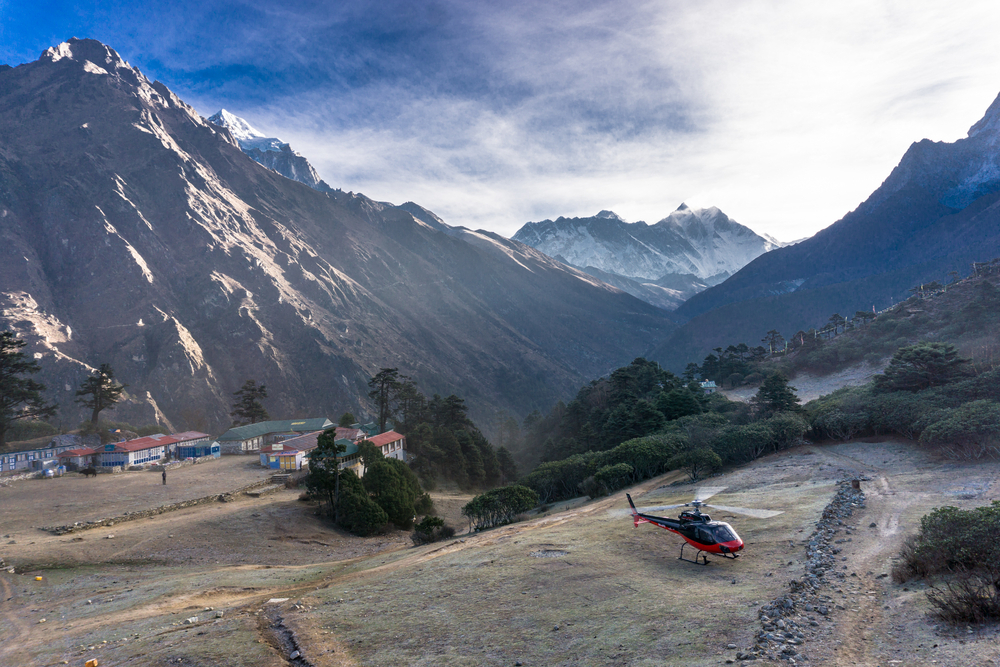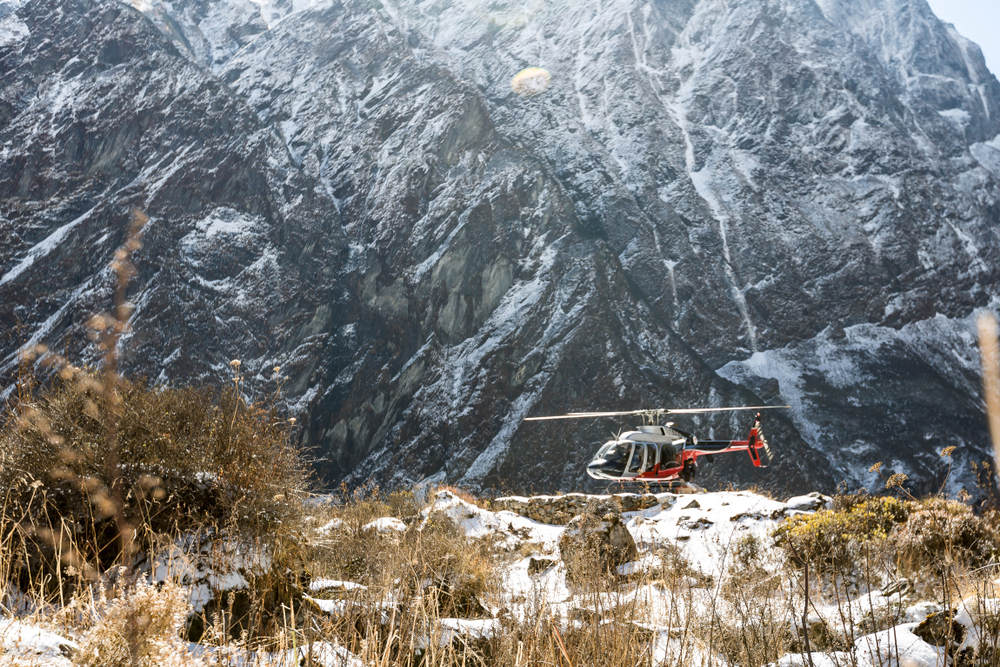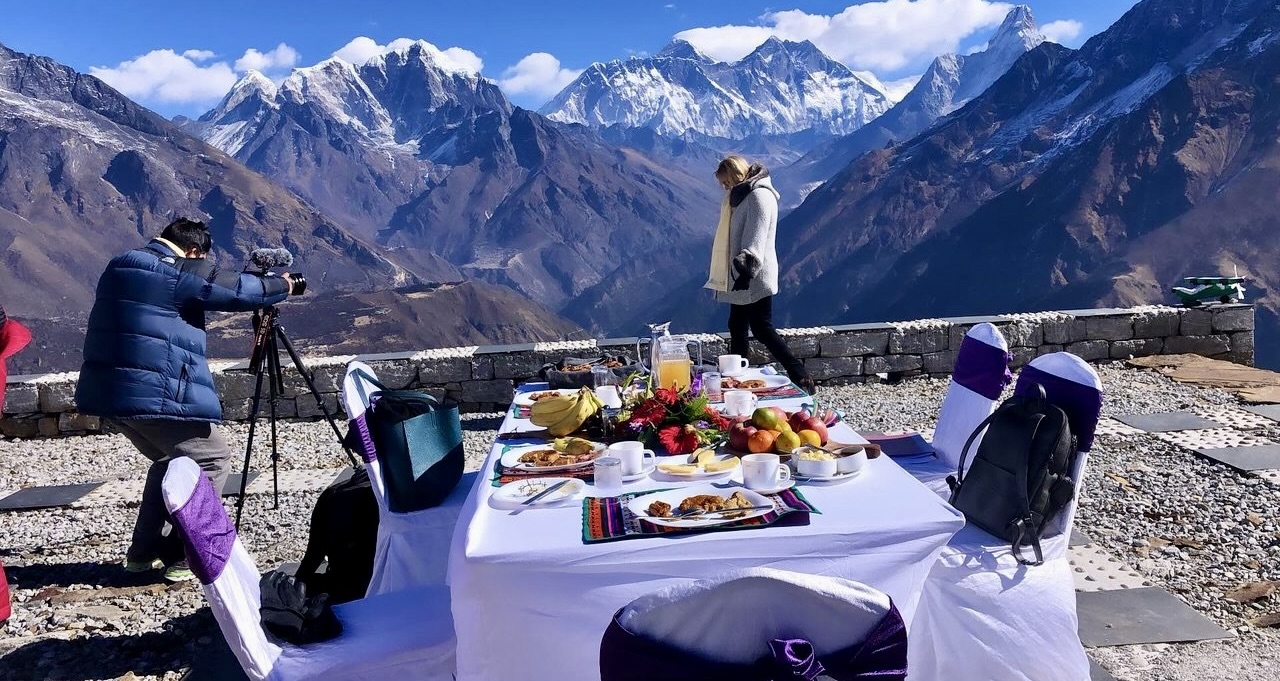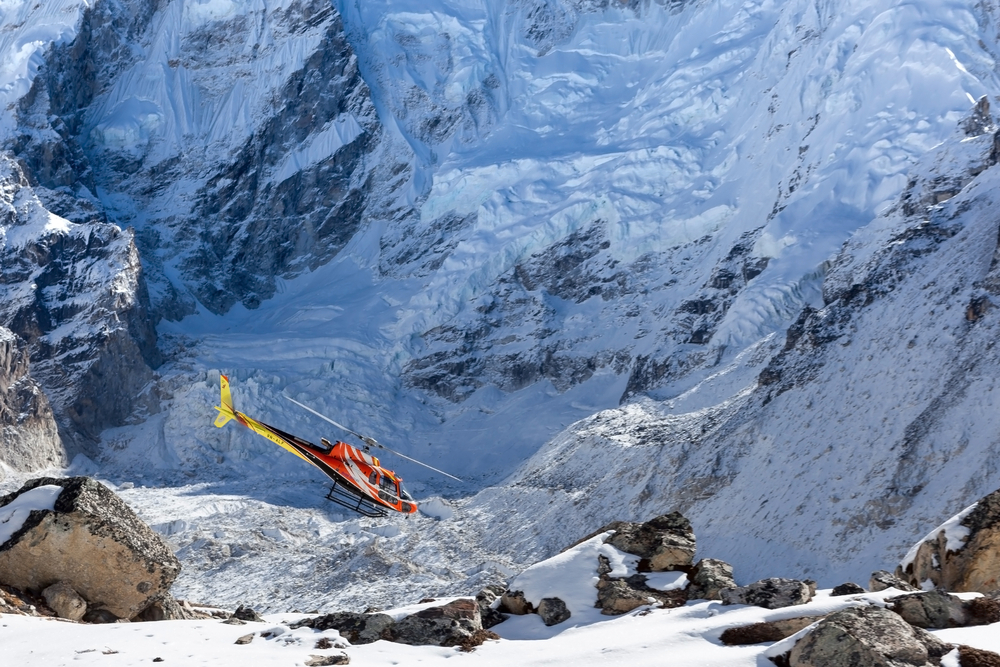- Here's what you can expect on an Everest Base Camp Helicopter Tour
- What is the best time of year to take an Everest base camp helicopter tour?
- What is the weather like during the recommended seasons for the Everest base camp helicopter tour?
- What is the average temperature during the recommended seasons for the Everest Base Camp Helicopter Tour?
- Helicopter landing point in Everest Region
- What is the duration of the Everest Base Camp helicopter tour?
- What is the minimum age requirement for the Everest base camp helicopter Tour?
- Breakfast during the Everest Base Camp Helicopter Tour
- What is the menu for breakfast during the Everest Base Camp helicopter tour?
- What is the duration of the helicopter flight to Kalapathar during the Everest Base Camp helicopter tour?
- Packing list for Everest base Camp Helicopter Tour
- What is the procedure for boarding and disembarking the helicopter during the Everest Base Camp helicopter tour?
- FAQs
An Everest Base Camp Helicopter Tour is a thrilling and convenient way to experience the majestic Himalayas for those who are short on time or unable to trek to the base camp. The tour typically takes off from Kathmandu and flies to the base camp, offering aerial views of the stunning landscape, including Kala Patthar, Everest Base Camp, and the Khumbu Glacier. Some tours also include a landing at the Hotel Everest View for breakfast and sightseeing. This option is suitable for individuals with limited time or physical constraints, as it provides an opportunity to witness the breathtaking beauty of the region in just a day. The tour is also popular for its ability to offer a unique perspective of the Everest region, escaping the crowds that typically accompany the traditional trek to Everest Base Camp.

POV: Chopper Getting ready for Take off
Instead of experiencing the classic 12- to 14-day trek, this tour whisks you away on a scenic helicopter ride, offering near-views of the Himalayas and landing you at Everest Base Camp (5,364 meters) in just a few hours. If you are considering Helicopter Tour to Everest, booking our helicopter tour will be a great option for those who want a lavish helicopter ride to Everest Base Camp. We prioritize safety and provide a memorable experience. The tour is designed to accommodate individuals of various ages and physical abilities, making it an accessible option for many travelers. Additionally, the tour offers a unique vantage point to capture the beauty of the Himalayas, including the world's highest peak, Mount Everest.
Here's what you can expect on an Everest Base Camp Helicopter Tour
Though the helicopter tour to Everest Base Camp offers lots of expectations for visitors along this journey, Let's get into detail about the starting journey to the end of the Helicopter Trip to Everest.
The Journey to Everest Base Camp
In Kathmandu, the commencement of your adventure unfolds. A modern helicopter awaits, poised to transport you into the skies. As it ascends, you witness the vibrant city and lush valleys shrinking beneath, making way for the majestic Himalayan peaks. Ama Dablam, Lhotse, and Nuptse reveal themselves, casting imposing shadows over the glaciers. The anticipation intensifies as Everest looms on the horizon, its colossal form piercing through the clouds, its icy summit dominating the surroundings. From an aerial perspective, the sheer scale and magnificence of Everest evoke a profound sense of awe. The helicopter maneuvers skillfully through valleys, navigating the treacherous Khumbu Icefall—a maze of crevasses and towering ice walls—before gracefully landing at Everest Base Camp.
Helicopter Landing at Everest Base Camp
Once you cross the windy plateaus of Everest Base Camp, you are met with an incredible sight: an enormous area covered with prayer flags flapping in the breeze, together with the improvised homes of climbers and a collection of tents and lodges that act as a temporary haven for those who dare to reach the summit of Everest. Take a moment to take in the breathtaking view of the surroundings. Standing towering and quite palpable from this vantage point is the beautiful Everest, with its snowy pinnacle. The vista is further enhanced by the sight of other Himalayan colossi like Pumori and Changtse from this high sanctuary. For the more daring among you, there's a short climb to the neighboring Kalapatthar, a rocky knoll offering even more amazing views of the surrounding hilly scenery.
The Return Journey from Everest Base Camp
As you ascend back into the helicopter, prepare for another round of breathtaking sights. The return journey offers a different perspective of the Himalayas, revealing hidden valleys, cascading waterfalls, and remote villages clinging to the mountainside. As you land back in Kathmandu, you'll carry with you memories that will last a lifetime. The Everest Base Camp Helicopter Tour is a once-in-a-lifetime opportunity to experience the magic of the Himalayas and stand in the shadow of the world's tallest mountain.
Things to keep in mind during the Helicopter Tour to Everest Base Camp
In preparation for the awe-inspiring journey to Everest Base Camp, acclimatization is paramount due to the challenging high altitude. It's advisable to spend a few days in Kathmandu or a lower-altitude destination before embarking on the tour. While helicopter tours come with a higher price tag, they offer a distinct and unforgettable experience, especially for those with time constraints or physical limitations hindering traditional trekking.
Once at Everest Base Camp, be mindful of the thin air. Take the necessary time to acclimatize, paying close attention to your body's signals. Dressing warmly in layers is crucial, given the notably colder temperatures compared to Kathmandu. And, of course, don't forget your camera; every moment of this extraordinary journey deserves to be captured.
For those seeking a different perspective of the Himalayas, the Everest Base Camp Helicopter Tour from Kathmandu is an adventure not to be missed. Consider swapping trekking poles for a helicopter seat; the sky becomes your playground, and Everest beckons.
However, this narrative only scratches the surface of the magic that unfolds during a helicopter tour to Everest Base Camp. The actual experience is a sensory symphony, a blend of captivating sights, sounds, and emotions that will imprint on your memory forever. So, pack your sense of wonder, secure yourself in, and get ready to be spellbound by the majestic grandeur of the Himalayas.
What is the best time of year to take an Everest base camp helicopter tour?
The best time of year to take an Everest Base Camp Helicopter Tour is during the spring season, which lasts from March to May. During this time, the weather is pleasant and the skies are clear, providing excellent visibility of the Himalayas. Additionally, the flora and fauna are in full bloom, making for a beautiful and colorful landscape.

Helicopter landing at Syangboche During August
Autumn, from September to November, is also a recommended season for the tour, as it offers clear skies and stable weather. It's important to avoid the monsoon season, which lasts from June to August, as heavy downpours can make the flight challenging. November is also a good time for the tour, as it is the best time for trekking to Everest Base Camp or a helicopter tour.
What is the weather like during the recommended seasons for the Everest base camp helicopter tour?
During the recommended seasons for the Everest Base Camp Helicopter Tour, the weather is generally pleasant, with clear skies and good visibility. The best time for the tour is during the spring season, which lasts from March to May, and autumn, from September to November. During these seasons, the weather is moderate and the skies are clear, providing excellent visibility of the Himalayas. The landscape is vibrant, and the flora and fauna are in full bloom, making for a beautiful and colorful landscape. The winter season, from December to February, offers a distinct and tranquil charm, with snow-covered landscapes and pristine vistas, but the weather can be harsh, and flight may not be possible on some days due to winter storms and foggy skies. It's important to avoid the monsoon season, which lasts from June to August, as heavy downpours can make the flight challenging.
Engage with our experts to find out about Everest's current state.
What'sapp: +977-9801017030
Viber: +977-9801017030
What is the average temperature during the recommended seasons for the Everest Base Camp Helicopter Tour?
The average temperature during the recommended seasons for an Everest Base Camp Helicopter Tour is as follows:
- Spring (March to May): Daytime temperatures range between -10°C and 5°C, dropping to -20°C at night.
- Autumn (September to November): Temperatures are mild, with daytime temperatures reaching about 15°C and the minimum temperature dropping to -5°C at night.
It's important to note that the temperature can vary at different elevations, and weather conditions in the Himalayas can be unpredictable. Therefore, it's essential to be prepared for cold temperatures, especially at higher altitudes, regardless of the specific season.
Helicopter landing point in Everest Region
The helicopter landing point for a Tour to Everest Base Camp by Helicopter is typically at a nearby helipad, as landing at Everest Base Camp itself can be challenging due to the altitude and unpredictable weather conditions. The camp is located at an elevation of approximately 5,364 meters (17,598 feet), which can make it difficult for helicopters to operate safely and efficiently. The thin air at this altitude can affect the helicopter's performance, making it harder to take off and land. Additionally, the weather conditions at Everest can be unpredictable and change rapidly, with high winds, low visibility, and sudden storms that can make it difficult or impossible for helicopters to land or take off safely. Therefore, most helicopter tours land at a nearby helipad, such as Kala Patthar, which offers stunning views of the Himalayas and cultural experiences.
What is the duration of the Everest Base Camp helicopter tour?
The duration of an Everest Base Camp Helicopter Tour with a landing typically ranges from 4 to 5 hours. The tour includes the flight from Kathmandu to Lukla, then to Everest Base Camp, and finally back to Kathmandu. The actual duration may depend on weather conditions and the specific itinerary of the tour. Additionally, the helicopter tour provides an opportunity to enjoy aerial views of Kala Patthar, Everest Base Camp, and the Khumbu Glacier, offering a unique and memorable experience of the Everest region.
What is the minimum age requirement for the Everest base camp helicopter Tour?
The minimum age requirement for a Helicopter Ride to Everest Base Camp is not specified, and there are no age restrictions for participating in this tour. The tour is open to individuals of all age groups, including children and elderly individuals. The tour is considered suitable for anyone who meets the minimum age requirements and is in good health. It's important to consider the health and physical condition of the participants, especially when traveling to high altitudes, and to consult with a doctor or medical professional before joining the tour, especially for children and elderly individuals.
Breakfast during the Everest Base Camp Helicopter Tour
During an Everest Base Camp Heli Tour, you can enjoy a delectable breakfast with stunning views of Mount Everest. The breakfast is typically served at a scenic location, such as the Everest View Hotel in Syangboche, where you can admire the majestic Mt. Everest while savoring your meal.

Cient enjoying breakfast and capturing memories in Everest
The breakfast experience is designed to be a luxurious and memorable part of the tour, offering a unique blend of adventure and gastronomy amidst the serene backdrop of the Himalayas. The tour is crafted to provide an unparalleled experience that combines the best of nature, culture, and luxury, making it an extraordinary adventure for travelers.
What is the menu for breakfast during the Everest Base Camp helicopter tour?
The menu for breakfast during an Everest Base Camp Helicopter Tour is not explicitly mentioned in the search results. However, based on the information available, the breakfast is typically served at the Everest View Hotel in Syangboche, which is known for its luxurious dining experience. The hotel offers a variety of mouthwatering breakfast choices, allowing you to wake up your senses with a symphony of flavors. Some of the breakfast options at the hotel may include:
- Local Flavors: Traditional Nepalese dishes, such as momos, thukpa, and dal bhat, are popular among locals and tourists alike.
- Continental Dishes: A selection of international dishes, such as pancakes, waffles, and omelets, catering to a diverse range of tastes.
- Beverages: A variety of hot and cold beverages, including freshly brewed coffee, warm butter tea, and fresh fruit juices, to complement your meal.
Please note that the specific menu items may vary depending on your package type and the hotel's offerings at the time of your visit.
What is the duration of the helicopter flight to Kalapathar during the Everest Base Camp helicopter tour?
The duration of the helicopter flight to Kalapathar during an Everest Base Camp Helicopter Tour is approximately 25 minutes. This flight takes you from Lukla to Kalapathar, allowing you to experience the breathtaking views of the Everest region from the air. Additionally, the helicopter lands at Kalapathar for a very short duration, typically around 10–15 minutes, during which you can enjoy the closest views of Mt. Everest and the surrounding peaks before returning to your departure point.
Packing list for Everest base Camp Helicopter Tour
 (1)-1.png)
The packing list for an Everest Base Camp Helicopter Tour typically includes essential items to ensure a safe and comfortable experience. Here's a summary of the recommended items based on the search results:
- Clothing: Layered clothing for varying temperatures, waterproof jackets, insulated jackets, hiking pants, moisture-wicking base layers, a warm hat, gloves, and sturdy hiking boots.
- Personal Items: sunscreen, sunglasses, lip balm, personal medications, a first-aid kit, toiletries, and a quick-dry towel.
- Accessories: daypack, duffel bag, headlamp or flashlight, trekking poles, and camera for capturing the stunning views.
- Miscellaneous: reusable water bottle, snacks, cash (local currency), and necessary travel documents.
It's important to pack light and prioritize essential items, considering the weight and space limitations of the helicopter. Additionally, the specific packing list may vary based on the tour operator and individual preferences.
What is the procedure for boarding and disembarking the helicopter during the Everest Base Camp helicopter tour?
The procedure for boarding and disembarking the helicopter during an Everest Base Camp helicopter tour involves several safety measures and guidelines to ensure a secure and enjoyable experience. Here are the key steps based on the provided search results:
Boarding the helicopter
- COVID-19 Safety: All individuals boarding the helicopter are required to have masks, and face shields and to use hand sanitizers.
- Safety Precautions: Passengers are advised to wear seat belts properly after boarding the helicopter and not to rush while getting inside the helicopter.
- Weight Limit: The helicopter typically has a weight limit, and the number of passengers may be restricted to ensure safety and compliance with weight regulations.
Disembarking the helicopter
- Safety Precautions: Passengers are advised not to rush while getting outside the helicopter and not to throw anything out of the window.
- Duration: The landing at Kalapathar is typically around 10–15 minutes, allowing passengers to enjoy the views before returning to the helicopter.
These safety measures and guidelines are in place to prioritize the well-being and security of all passengers during the Everest Base Camp Helicopter Tour.

Helicopter Preparing for Landing in Base Camp
In conclusion, the Everest Base Camp Helicopter Tour stands as a remarkable fusion of adventure and caution, weaving through the challenges presented by the formidable altitude and ever-changing weather conditions. The decision to land at a nearby helipad, wisely avoiding the complexities of Everest Base Camp itself, underscores the commitment to safety and ensures an unforgettable experience for all adventurers.
As the helicopter hovers over the majestic Himalayas, passengers are treated not only to breathtaking views but also to the realization that nature's grandeur demands respect. The narrative of this tour, from the anticipation in Kathmandu to the strategic landing at Kala Patthar, reflects the delicate dance between human exploration and the untamed forces of the mountains.
So, whether you are drawn to the allure of Everest for its iconic peaks or the thrill of a helicopter ride through the sky, the Everest Base Camp Helicopter Tour beckons with a promise of awe, wonder, and a newfound appreciation for the harmonious coexistence of adventure and prudence in the heart of the Himalayas.
FAQs
1. Are there any specific health considerations for passengers regarding altitude sickness during the helicopter tour?
- Passengers should be aware of the potential for altitude-related issues. It's recommended to consult with a healthcare professional before the tour, especially for individuals with pre-existing health conditions.
2. How does booking for the Everest Base Camp Helicopter Tour work, and what information is required during the booking process?
- Booking typically involves providing personal details, confirming the number of passengers, selecting a preferred date, and making the necessary payment. It's advisable to book well in advance to secure preferred dates.
3. Can I book the Everest Base Camp Helicopter Tour on short notice, or is it recommended to book in advance?
- While last-minute bookings may be possible, it's generally recommended to book in advance. This ensures availability, allows for better scheduling, and provides ample time for necessary preparations.
4. What factors should I consider when choosing the best time to book the Everest Base Camp Helicopter Tour?
- The best time to book depends on personal preferences and the preferred season for the tour. Consider factors like weather conditions, peak tourist seasons, and personal schedules when making a decision.
5. What happens if there is a weather alteration affecting the Everest Base Camp Helicopter Tour on the scheduled day?
- In the event of adverse weather conditions, the tour may be rescheduled or canceled for safety reasons. Passengers should be flexible with their schedules, and tour operators will make the necessary arrangements.
6. Are there any alternatives or contingency plans in case the Everest Base Camp Helicopter Tour is impacted by weather?
- We often have contingency plans, such as alternative routes or rescheduling options. Passengers should stay in communication with us for updates and potential alternatives.
7. How is weather information monitored, and how early are decisions made regarding the status of the Everest Base Camp Helicopter Tour?
- Weather information is monitored through reliable sources. Decisions regarding the tour status are typically made in advance, prioritizing passenger safety and ensuring a smooth experience.
8. What is the highest altitude reached during the Everest Base Camp Helicopter Tour?
- The Everest Base Camp Helicopter Tour reaches its highest altitude during the landing at Everest Base Camp, which is approximately 17,600 feet above sea level. This provides passengers with a unique and immersive experience in the Himalayan highlands.
9. How difficult is the Everest Base Camp Helicopter Tour?
- The Everest Base Camp Helicopter Tour is not physically demanding and is accessible to individuals of all fitness levels. It offers a comfortable and scenic journey, making it suitable for a wide range of participants.
10. What is the approximate duration of the Everest Base Camp Helicopter Tour from Kathmandu?
- The Everest Base Camp Helicopter Tour from Kathmandu typically lasts for about 4 to 5 hours. The duration may vary depending on weather conditions, air traffic, and the specific route taken by the helicopter.







